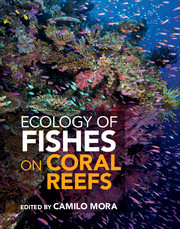Book contents
- Frontmatter
- Contents
- Preface
- Foreword
- List of contributors
- PART I BASIC ECOLOGY
- PART II PATTERNS AND PROCESSES
- 6 The evolution of fishes on coral reefs: fossils, phylogenies, and functions
- 7 Phylogeography of coral reef fishes
- 8 How many coral reef fish species are there? Cryptic diversity and the new molecular taxonomy
- 9 Large-scale patterns and processes in reef fish richness
- 10 Patterns and processes in geographic range size in coral reef fishes
- 11 Patterns and processes in reef fish body size
- 12 Multi-scale patterns and processes in reef fish abundance
- PART III HUMAN FINGERPRINTS
- PART IV CONSERVATION
- PART V DEBATES AND PARADIGM SHIFTS
- References
- Index
10 - Patterns and processes in geographic range size in coral reef fishes
from PART II - PATTERNS AND PROCESSES
Published online by Cambridge University Press: 05 May 2015
- Frontmatter
- Contents
- Preface
- Foreword
- List of contributors
- PART I BASIC ECOLOGY
- PART II PATTERNS AND PROCESSES
- 6 The evolution of fishes on coral reefs: fossils, phylogenies, and functions
- 7 Phylogeography of coral reef fishes
- 8 How many coral reef fish species are there? Cryptic diversity and the new molecular taxonomy
- 9 Large-scale patterns and processes in reef fish richness
- 10 Patterns and processes in geographic range size in coral reef fishes
- 11 Patterns and processes in reef fish body size
- 12 Multi-scale patterns and processes in reef fish abundance
- PART III HUMAN FINGERPRINTS
- PART IV CONSERVATION
- PART V DEBATES AND PARADIGM SHIFTS
- References
- Index
Summary
Coral reef fishes vary dramatically in the extent of their geographic distributions, and the patterns, causes, and consequences of this extensive variation have long interested coral reef fish ecologists. Although there is still a great deal of uncertainty regarding the drivers of range size variation in coral reef fishes, research over the last several decades has greatly improved our understanding. Ecologists once suspected that larval traits, primarily pelagic larval dispersal potential, had a strong influence on species' ranges, but recent synthetic work has shown that larval dispersal only impacts range sizes when ranges cross the greatest dispersal barriers in the Pacific. Emerging work suggests that adult traits, such as body size, habitat preferences, and even nocturnal activity are correlated with range size, likely by increasing persistence of newly established populations. Processes that operate over evolutionary scales are also likely important, but it has been challenging to empirically examine these factors. However, the quantity and availability of biological information are increasing rapidly, providing reef fish ecologists with richer datasets with which to evaluate a broader range of hypotheses.
One of the most fundamental traits of a species is the size of its geographic range. Coral reef fishes show dramatic variation in range size, and even closely related species can have vastly different geographic extents. For example, the surge wrasse Thalassoma purpureum extends from South Africa to Central and South America, a span of nearly 28 000 km, while the Clipperton wrasse Thalassoma robertsoni is endemic to Clipperton Atoll in the tropical eastern Pacific, an island approximately 6 km long (Figure 10.1). Therefore, it is not surprising that this variation has interested coral reef biologists and biogeographers for decades.
The size of a species' range is likely the product of a wide variety of biotic and abiotic forces and as such can provide great insight into biogeographic and evolutionary patterns. Geographic range size can also have a large impact on a species' extinction risk, since widespread species are thought to be much less vulnerable to extinction than geographically restricted species [357, 915].
Information
- Type
- Chapter
- Information
- Ecology of Fishes on Coral Reefs , pp. 97 - 103Publisher: Cambridge University PressPrint publication year: 2015
Accessibility standard: Unknown
Why this information is here
This section outlines the accessibility features of this content - including support for screen readers, full keyboard navigation and high-contrast display options. This may not be relevant for you.Accessibility Information
- 8
- Cited by
